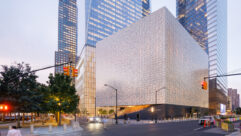SVC Podcast – Show Notes – Show 137-1:
In this edition of the SVC Podcast, SVC Contributing Editor Bennett Liles talks with Bob Ehlers, Vice President of Marketing for RGB Spectrum, a company specializing in control room and command center design and installation. Bob outlines the installation of a mission critical video monitoring system for NASA’s Payload Operations Center where they coordinate experiments on the International Space Station and communicate with spacecraft flying to other planets.
Links of interest:
- RGB Spectrum, specializing in control rooms and command centers
- NASA’s Payload Operations Center in Huntsville, Alabama
- The OmniWall 16/32 Display Processor
Download Podcast Here:
https://s3.amazonaws.com/nb-svc/public/public/137-1_NASA_RGB_Spectrum_1_…
From Sound & Video Contractor Magazine, this is the SVC Podcast with Bob Ehlers of RGB Spectrum. Show notes for the podcast are available on the web site of Sound & Video Contractor Magazine at svconline.com.
When you have a spacecraft flying by a planet there’s no time for a video system failure, so NASA called in RGB Spectrum to outfit their new Payload Operations Center with video displays and routing. VP of Marketing Bob Ehlers is here to talk to us about how they installed the mission-critical video system, and that’s coming up next on the SVC Podcast.
Bob, thanks for being with us for the SVC Podcast from RGB Spectrum. And we’re talking about NASA’s Payload Operations Center where you did a big control room installation. They’re talking to the International Space Station all the time. They handle things out of there; coordinate experiments. They did the Pluto fly-by. I believe they did it right out of that room, but before we get into those details tell us a little about RGB spectrum and what’s going on there.
Thanks, Bennett. Yeah, RGB Spectrum has been around for almost 30 years making display wall processors, Codex devices for multi viewing and keying and video processing. We’ve focused primarily on control rooms and command and control systems. We offer devices and systems and solutions for multi-user control room management. And call us; we’ve got lots of different solutions out there for whatever your control room needs might be. [Timestamp: 1:49]
And contrary to some other installation projects where you might just be putting in a pair of speakers here or there, you can really get into some very creative situations on control rooms and command centers. So this was NASA. It’s a government agency with all that’s involved on that, but what kind of a place is the Payload Operations Center?
Well that’s the Marshall Flight Control Center down in Alabama and it’s one of the main locations where flight control for a lot of satellites and exploratory programs are run. It’s basically kind of a state-of-the-art facility for managing ground support for the international space station. It was involved most recently with the New Horizon fly-by that was going out past Pluto and there was a lot of telemetry and control going on there. It really is the showcase for advanced audio and video technologies. They’ve got an extremely large wall, they’ve got many, many operators. The information that is up on the wall is time-critical, mission-sensitive, and we’re in there primarily because our equipment is very, very reliable. We have very, very high image quality. We don’t have any artifacts. We have very, very fast switching time. And so when somebody needs to look at visual information in a highly-available – and under high scrutiny, right, because these people are looking at this information and they’re looking for minute details in the imagery that’s coming back from these remote vehicles that might be orbiting the Earth or flying away from the Earth, and they don’t want to lose any of those details while they’re looking at it. It’s also used for abnormal situation management and control in those types of instances. [Timestamp: 3:46]
I know that they’ve got a lot of workers there who need to be coordinated in what they’re seeing and switching various sources. They’ve got computers, video feeds. What else are they watching?
They have everything, as you say, from computer outputs which might be SCADA human management interface systems where they’re actually looking at the machinery that’s being operated either on ground control systems or up on the remote devices. They’re looking at news feeds from different sources. They may be looking at weather information. There’s, again, a whole range of things and they may be looking at video feeds that are coming in as IP streams, H264 streams, etc. Generally, what the OmniWall processor, which is our 32-port processor that is running the room is allowing them to do is take those 32 different input signals, combine them and display them simultaneously on the wall as windows side by side or scaling across multiple monitors so that they can get the resolution that they need and get the detail that they want form those individual systems. They can also put the systems up there next to each other to be able to do comparative analysis. And one of the main things that our systems do is we have very, very low latency and so they can look at it frame by frame and see all the data in real time to make those real-time comparisons that they need as they’re monitoring experiments and crew in space and things like that. [Timestamp: 5:26
And you installed the OmniWall 32 Processor for that?
That’s correct. That’s correct.
So what all can it do?
It accepts up to 32 inputs and can have 32 outputs. I believe in this installation it’s for the most part standard DVI inputs that they’re routing to the system and so all the computer systems are in close proximity. But that system also supports inputs from HDBaseT sources over extenders. We have fiber sources that can be put into it and we can take those as inputs and outputs and be able to extend the distances so if we needed to run it to a remote display somewhere we could certainly do that. [Timestamp: 6:10]
Okay, and those links are coming in by a lot of different ways. They have direct down links for sure form the Space Station, but there are signals coming in from other terrestrial locations and things like that?
Yeah. I mean really we’re agnostic to where the sources are coming from and that’s part of the beauty of our system is. We’re taking standard video signals and allowing multiple disparate systems to be integrated together. I mean the only thing that the sources have to share is that they’re outputting a video signal of some type whether it’s VGA all the way up to 1080p. We even do 1920 x 1200, so a higher resolution than even 1080p. And so we can combine all those sources into the wall and we can output them to the contiguous wall and then we can also output them to side monitors for monitoring and viewing that may not be contiguous to the wall. So we can define smaller walls within the system. [Timestamp: 7:209]
Does this system have any kind of redundant power or a power fail-over feature?
Yeah. The OmniWall 32 has redundant power supplies. They’re hot swappable power supplies and those are fed from disparate power sources. They can be removed and injected as they need to. Fortunately for this system it has never required really any replacement in its timed operation. I believe it’s been in a little over a year and a half now. It went in, I think, in about August of 2013. [Timestamp: 7:48]
I’m sure that as critical as it is in that facility they’ve got all kinds of backup power for everything.
Yeah. And that’s true. This is not kind of your typical stressful environment where people are putting it to the test. We have other customers where they’ve installed our OmniWall or our link switchers, our media wall processors, and certainly they’re not as friendly. We’ve had them taken out by the military into tents in the sand and of course they cake the air filters on the devices right up and the units are designed for the air filters to be extracted and blown clean and they can be washed up and reused right away. And of course the power is always an issue, whether it’s being stabilized or not. Our systems are designed for a wide range of operating conditions. Whether they’re getting sags or surges on the power supplies they clean up pretty well and those are not reflected in any of the video elements up on the wall. [Timestamp: 8:49]
Yeah, their power situation would be an interesting story in itself, but it has been great hearing about how they do this in such a high-profile and mission-critical environment. As we said before there are no take two’s when you have a spacecraft flying by a planet.
No. You put the space station up there and you’ve got probably a couple billion dollars in equipment circling the Earth. You don’t want to lose communication and you don’t want to lose situational awareness of what’s going on up there because you’ve got life safety and you’ve got a huge investment in resources. [Timestamp: 9:21]
And that’s a real statement about their trust and confidence in RGB Spectrum to have your guys come in and install this totally mission-critical video system. And we’ll get into more details on the installation process in Part 2. It’s Bob Ehlers, VP of Marketing with RGB Spectrum and the video system at NASA’s Payload Operations Center. Thanks for telling us about it, Bob.
Thank you, Bennett.
Thank you for being here with us for the SVC Podcast with Bob Ehlers. Show notes are available on the website of Sound & Video Contractor Magazine at svconline.com. Be back with us for Part 2 when Bob will tell us more about the Payload Operations Center video displays and about how display wall processors are setup, tested and evaluated. That’s on the next SVC Podcast.










